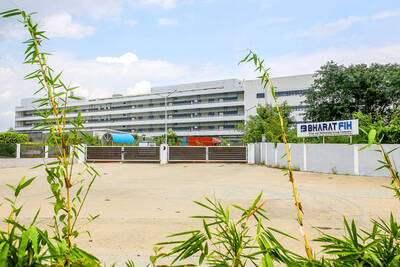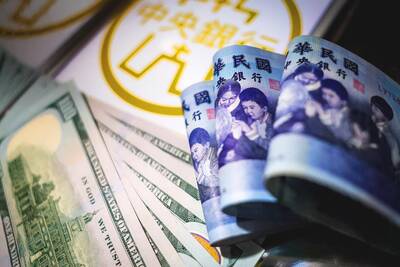Local drug developer Orient Pharma (友霖生技) said yesterday its oral solution for excessive drooling is likely to be licensed to US companies by the end of this year.
In addition, a generic drug for diabetes is also likely to be approved by the US government by the fourth quarter and become the first generic drug for diabetes on the US market, Orient Pharma spokesperson Anita Chen (陳嬿娟) said at a biotechnology exhibition and conference yesterday.
The four-day Bio Taiwan is taking place at the Taipei World Trade Center.
Orient Pharma’s oral solution has completed the second phase of clinical trials and the results were presented at the 17th international congress of Parkinson’s disease and movement disorders in Sydney, Australia, last month.
The company said most people with central nervous system problems suffer excessive drooling and that according to a WHO estimate, the annual US market for central nervous system diseases is valued at US$70 billion and that for new diabetes treatments is about US$3 billion.
Meanwhile, local drug maker SynCore Biotechnology Co (杏國新藥) said that Veregen, its cure for genital warts, had received a permit from the government and will be on sale by the end of this quarter.
The company said it is also planning to become a listed company on the Emerging Stock Market, but did not provide a specific date.
HIGH EXPECTATIONS
Medical care equipment suppliers are also participating at this year’s event amid high expectations that they will soon be included in a government subsidy program.
In his opening speech at the event, President Ma Ying-jeou (馬英九) said that the government would include the development of high-risk medical devices into a subsidy program in an amendment to the Act for the Development of the Biotech and New Pharmaceuticals Industry (生技新藥產業發展條例).
The amendment of the act is set to be reviewed by the legislature in the September to December session, Ma said.
Total revenue for the local biomedical industry last year was NT$263 billion, up 10 percent from the previous year, a higher increase than many industries, Ma said.
However, most companies in the biomedical industry are small and medium-sized enterprises, Ma said, adding that the government aims to support the industry and increase its total output to NT$500 billion by 2020, with the revenue of each of the top five companies exceeding NT$10 billion.
Separately, Medical supply provider Nang Kuang Pharmaceutical Co (南光化學製藥) said its prefilled syringe, which is used to clean a central venous catheter or an implanted port, had successfully been used by National Taiwan University Hospital and Shin Kong Wu Ho-su Memorial Hospital.
“The Bureau of National Health Insurance is likely to agree to cover the cost of our prefilled syringe by next quarter,” Nang Kuang sales director Song Chih-jen (宋智仁) said.
The prefilled syringe cuts risks of contamination when cleaning a patient’s central venous catheter or implanted port, Song said.

SETBACK: Apple’s India iPhone push has been disrupted after Foxconn recalled hundreds of Chinese engineers, amid Beijing’s attempts to curb tech transfers Apple Inc assembly partner Hon Hai Precision Industry Co (鴻海精密), also known internationally as Foxconn Technology Group (富士康科技集團), has recalled about 300 Chinese engineers from a factory in India, the latest setback for the iPhone maker’s push to rapidly expand in the country. The extraction of Chinese workers from the factory of Yuzhan Technology (India) Private Ltd, a Hon Hai component unit, in southern Tamil Nadu state, is the second such move in a few months. The company has started flying in Taiwanese engineers to replace staff leaving, people familiar with the matter said, asking not to be named, as the

The prices of gasoline and diesel at domestic fuel stations are to rise NT$0.1 and NT$0.4 per liter this week respectively, after international crude oil prices rose last week, CPC Corp, Taiwan (台灣中油) and Formosa Petrochemical Corp (台塑石化) announced yesterday. Effective today, gasoline prices at CPC and Formosa stations are to rise to NT$27.3, NT$28.8 and NT$30.8 per liter for 92, 95 and 98-octane unleaded gasoline respectively, the companies said in separate statements. The price of premium diesel is to rise to NT$26.2 per liter at CPC stations and NT$26 at Formosa pumps, they said. The announcements came after international crude oil prices

DOLLAR SIGNS: The central bank rejected claims that the NT dollar had appreciated 10 percentage points more than the yen or the won against the greenback The New Taiwan dollar yesterday fell for a sixth day to its weakest level in three months, driven by equity-related outflows and reactions to an economics official’s exchange rate remarks. The NT dollar slid NT$0.197, or 0.65 percent, to close at NT$30.505 per US dollar, central bank data showed. The local currency has depreciated 1.97 percent so far this month, ranking as the weakest performer among Asian currencies. Dealers attributed the retreat to foreign investors wiring capital gains and dividends abroad after taking profit in local shares. They also pointed to reports that Washington might consider taking equity stakes in chipmakers, including Taiwan Semiconductor

A German company is putting used electric vehicle batteries to new use by stacking them into fridge-size units that homes and businesses can use to store their excess solar and wind energy. This week, the company Voltfang — which means “catching volts” — opened its first industrial site in Aachen, Germany, near the Belgian and Dutch borders. With about 100 staff, Voltfang says it is the biggest facility of its kind in Europe in the budding sector of refurbishing lithium-ion batteries. Its CEO David Oudsandji hopes it would help Europe’s biggest economy ween itself off fossil fuels and increasingly rely on climate-friendly renewables. While